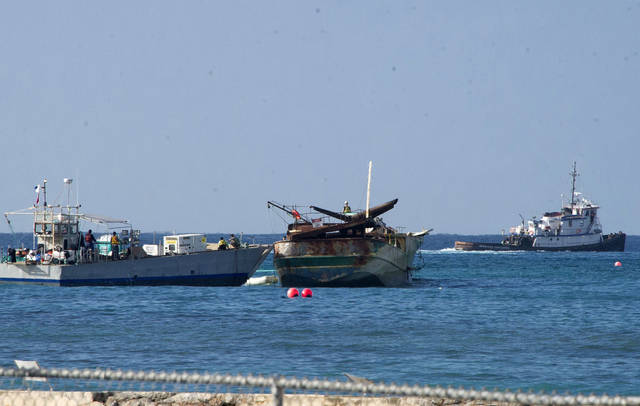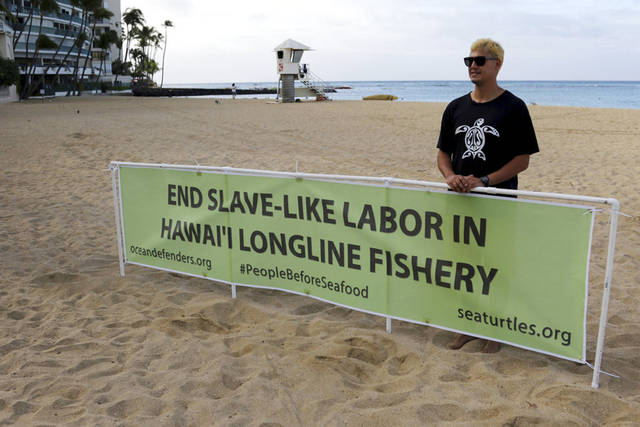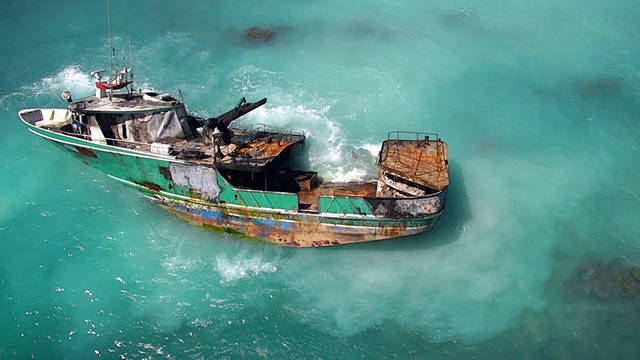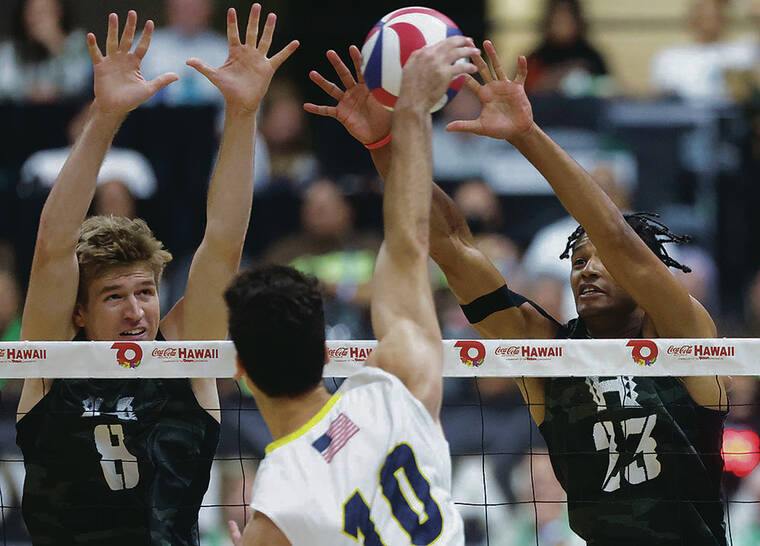Salvage crew removes fishing boat 2 months after grounding off Waikiki

CRAIG T. KOJIMA / ckojima@staradvertiser.com
The 79-foot fishing vessel Pacific Paradise, shown here on Tuesday, ran aground off the Natatorium in Waikiki on October 10, was removed today by a salvage crew.

CALEB JONES / Associated Press
Dylan Bedortha of the marine conservation group Turtle Island Restoration Network stands next to a protest banner on the beach near the wrecked fishing vessel Pacific Paradise in Honolulu on Nov. 30.

ASSOCIATED PRESS
This undated photo provided by the U.S. Coast Guard shows the 79-foot fishing boat Pacific Paradise, aground off Kaimana Beach in Waikiki. The boat was towed away today after two months on the shallow reef.



With the help of a small swell, salvage crews successfully towed the commercial fishing vessel Pacific Paradise out beyond the reef at Kaimana Beach this morning and expect to tow it out to a disposal site by sunset today, U.S. Coast Guard officials said.
At today’s 7 a.m. high tide, a tug boat successfully towed the 79-foot boat from its shallow, sandy bottom out to deeper sea of about 600 feet. Two tug boats were on hand to do the job.
“It went right as planned this morning,” said Coast Guard Operational Section Chief Gregg Maye. “It was a long time coming and we did a lot of planning. A lot of work went into making sure we did this safely and properly, and it was just a huge success this morning to watch the boat being towed away.”
The boat, which grounded into a shallow reef just off Waikiki before midnight on Oct. 10, has proven to be a challenge to remove over the past two months, leaking fuel, catching fire, and thwarting multiple salvage attempts.
Maye said today that crews are now preparing to sink the boat by opening up all the hatches and compartments while waters are calm. The transit to a disposal site about 13 miles south of Oahu, he said, will take about three hours.
He said the torch is now passed on to the state Department of Land and Natural Resources, which will continue to assess damages to the site and direct cleanup efforts.
Don't miss out on what's happening!
Stay in touch with breaking news, as it happens, conveniently in your email inbox. It's FREE!
On Tuesday, crews worked to repair a bulkhead between the fish hold and engine room by installing a 5-foot-by-6-foot metal plate underwater after original plans to tow the boat away at high tide over the weekend did not transpire. The intrusion of water into the fish hold was too severe, according to the Coast Guard, making the vessel too heavy. Another attempt at high tide Wednesday morning was unsuccessful.
The fishing boat, owned by TWOL LLC and registered to a Honolulu address, got stuck on the reef just before midnight on Oct. 10 with 20 aboard — one American captain and 19 foreign workers. The owner’s insurance is supposed to cover the removal costs, expected to be at least $1 million.
The crash raised new questions about the safety and working conditions of foreign laborers in the Hawaii fleet. No one aboard called for help when it crashed, and rescue teams responded to eyewitness reports. The rescued 19 foreign workers were taken by U.S. Customs and Border Protection agents to a pier to be interviewed and placed on other fishing boats.
A 2016 Associated Press investigation revealed the fishing fleet exploits a loophole in federal law to employ men from impoverished Southeast Asian and Pacific nations for a fraction of the pay an American worker would get, with some making as little as 70 cents an hour.
The men do not have authorization to enter the United States, so they are confined to boats while docked in Honolulu and not eligible for most basic labor protections. The AP report revealed instances of abuse and claims of human trafficking among the fleet.
Under the law, U.S. citizens must make up 75 percent of the crew on most American commercial fishing boats. But in Hawaii, the loophole carved out to support one of the state’s biggest industries exempts commercial fishing boat owners from the rules enforced almost everywhere else.
The recently introduced Sustainable Fishing Workforce Protection Act would close the loophole that has allowed the Hawaii fleet to employ the workers.
A banner reading “end slave-like labor in Hawaii longline fishery” had been placed on the beach near the wreck by an activist from Turtle Island Restoration Network, which has filed a complaint with the Inter-American Human Rights Commission.
Dylan Bedortha, the group’s advocacy associate who set up the sign, formerly worked as a National Oceanic and Atmospheric Administration observer in Hawaii’s longline fishing fleet. He said the conditions he saw on the boats as a federal employee made him change his career path.
“It took me a couple of years to really let all that sink in and see what was actually going on on some of the worse boats that I was on,” Bedortha said. “I decided to take a different direction and step into the conservation side of things.”
The commission is an autonomous body of the Organization of American States and works to protect human rights. The United States is a member.
The complaint asks the commission to determine the responsibility of the U.S. government for human rights abuses against foreign workers in Hawaii.
Most of the foreign workers aboard the Pacific Paradise were from Vietnam, Indonesia, Philippines and Kiribati, and they were not part of the regular crew. Officials said the boat was not on a fishing trip before it crashed.
Bryan Ho, the lawyer for boat owner Honolulu-based TWOL LLC, has declined requests for interviews.
The Associated Press contributed to this report.





